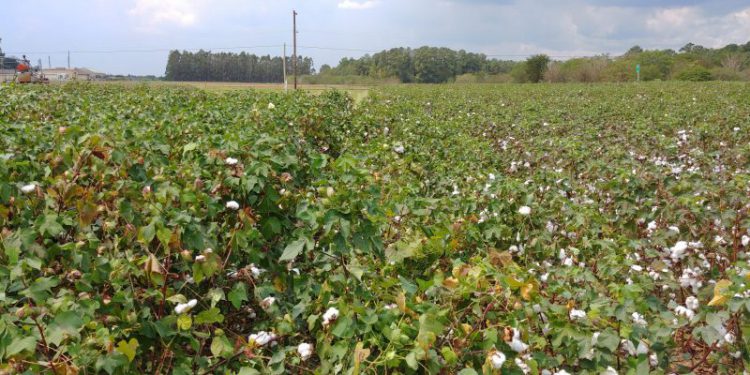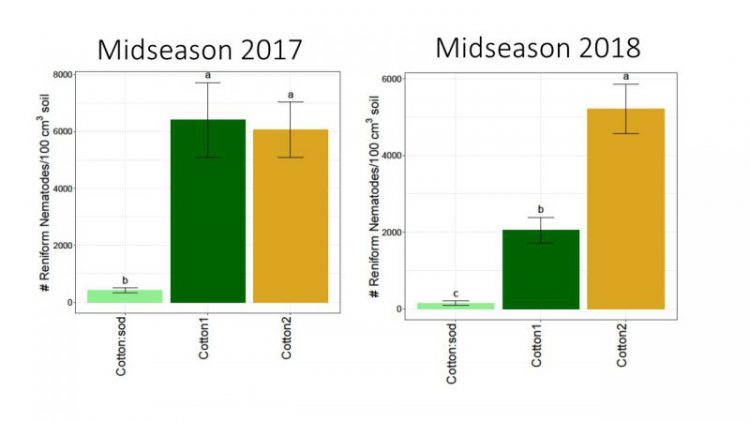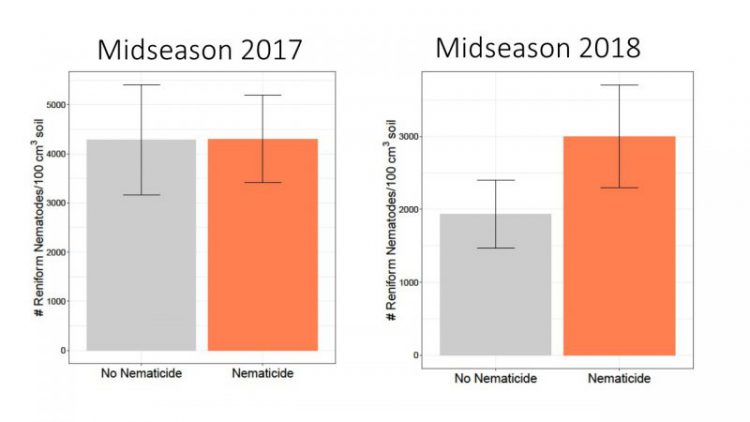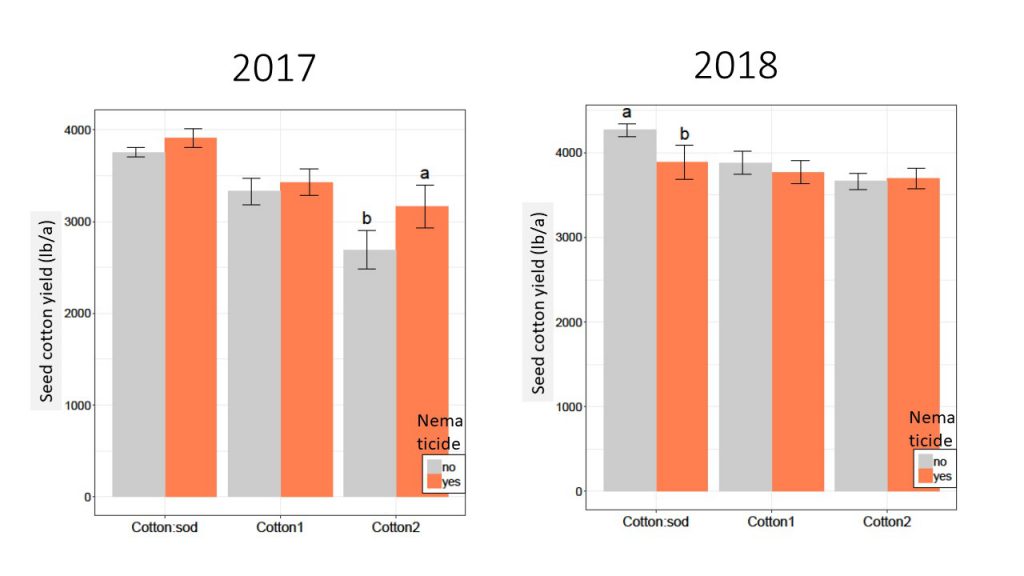Reniform nematode is a major pest of cotton. Unlike many other nematodes, it causes problems in a range of soils, including those with lower sand content. Management of this nematode currently relies on nematicide application and crop rotation. Fortunately, resistant cultivars are expected to be available in the near future. Often crop rotation and nematicide application are used together to manage this nematode, so that combination was the focus of recent research at the North Florida Research and Education Center-Quincy (NFREC). Specifically, UF/IFAS researchers investigated:
- Is crop rotation or nematicide application more effective for management of this nematode?
- Is nematicide application more necessary in short than long rotations?
These questions were investigated at the NFREC long-term sod-based rotation site (Fig 1). At this site, a conventional rotation of cotton-cotton-peanut, as well as a sod-based rotation of 2 years bahiagrass followed by peanut then cotton are in place. Both peanut and bahiagrass are non-host plants for reniform nematode, so populations are expected to decrease when those crops are grown. In 2017 and 2018, each cotton treatment (1st-year conventional cotton, 2nd-year conventional cotton, and sod-based cotton) was compared without a nematicide treatment and with Velum Total (active nematicidal ingredient fluopyram) liquid nematicide applied in-furrow at planting. Each year, reniform nematode populations and crop yield were measured.

Figure 1. Cotton in the sod-based rotation long-term research site at NFREC-Quincy.
–
In both years, crop rotation clearly helped manage mid-season reniform nematode abundances (Figure 2). Two consecutive years of cotton monoculture—within a conventional rotation—increased reniform nematode populations more than sod-based rotation, or 1st-year conventional cotton. In 2018, 1st-year cotton in a conventional rotation was better than 2nd-year cotton, but not as good as sod-based rotation. This shows that crop rotation helps with nematode management, and rotating to a non-host crop or crops for multiple years increases the benefits for nematode management, as compared with a single year of non-host cropping.

Figure 2. Reniform nematode soil populations at midseason (1.5 months after planting) in 2017 and 2018 as affected by crop rotation. “Cotton:sod” is cotton following 2 years of bahiagrass and 1 year of peanut. “Cotton1” and “Cotton2” are 1st-year and 2nd-year cotton in a cotton-cotton-peanut rotation. Treatments with different letters are significantly different.
–
In contrast, nematicide application did not affect midseason reniform nematode abundances (Figure 3). Cotton yield was greatest in sod-based rotation and less in conventional rotation (Figure 4). In 2017, nematicide application provided a yield increase in 2nd-year cotton, where nematode pressure was greater. In 2018 there was no benefit of applying nematicide in any rotation, so nematicide efficacy was inconsistent in this trial. This is in line with other cotton trials in Florida, and throughout the Southeast, that show year to year inconsistency in performance of nematicides, particularly liquid or granular products. In general, crop rotation produced more consistent nematode management.

Figure 3. Reniform nematode soil populations at midseason (1.5 months after planting) in 2017 and 2018 were not affected by in-furrow Velum Total nematicide application. Values are averaged across the different crop rotations.
–

Figure 4. Reniform nematode soil populations at midseason (1.5 months after planting) in 2017 and 2018 as affected by crop rotation and nematicide application. “Cotton:sod” is cotton following 2 years of bahiagrass and 1 year of peanut. “Cotton1” and “Cotton2” are 1st-year and 2nd-year cotton in a cotton-cotton-peanut rotation. Nematicide treatments with different letters (within crop treatment) are significantly different.
–
Quick takeaways from this study:
- Rotation with non-host crop(s) is an effective way to help manage reniform nematode. A longer rotation, such as including bahiagrass pasture, provides better management than a shorter rotation.
- Nematicide efficacy may be greater in shorter rotations where nematode pressure is higher. Year to year inconsistency should be expected when using nematicides. When scouting for nematodes and planning nematode management tactics, pay particular attention to fields in short rotations.
–
For more information on nematode management in cotton, use the following link for the UF/IFAS EDIS fact sheet on this subject:
Management of Plant-Parasitic Nematodes in Florida Cotton Production
- Salibro: A Recently-Registered Conventional Nematicide for Select Horticulture Crops - March 7, 2025
- What Cotton Cultivars have Resistance or Tolerance to Southern Root-knot and Reniform Nematode? - February 28, 2025
- How Well Do Root-Knot Nematode Resistant Peanut Cultivars Perform in Florida? - February 14, 2025
